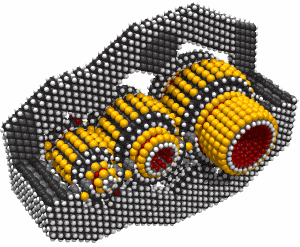
Today's manufacturing methods are very crude at the molecular level. Casting, grinding, milling and even lithography move atoms in great thundering statistical herds. It's like trying to make things out of LEGO blocks with boxing gloves on your hands. Yes, you can push the LEGO blocks into great heaps and pile them up, but you can't really snap them together the way you'd like.
In the future, nanotechnology will let us take off the boxing gloves. We'll be able to snap together the fundamental building blocks of nature easily, inexpensively and in most of the ways permitted by the laws of physics. This will be essential if we are to continue the revolution in computer hardware beyond about the next decade, and will also let us fabricate an entire new generation of products that are cleaner, stronger, lighter, and more precise.
It's worth pointing out that the word "nanotechnology" has become very popular and is used to describe many types of research where the characteristic dimensions are less than about 1,000 nanometers. For example, continued improvements in lithography have resulted in line widths that are less than one micron: this work is often called "nanotechnology." Sub-micron lithography is clearly very valuable (ask anyone who uses a computer!) but it is equally clear that conventional lithography will not let us build semiconductor devices in which individual do-pant atoms are located at specific lattice sites. Many of the exponentially improving trends in computer hardware capability have remained steady for the last 50 years. There is fairly widespread belief that these trends are likely to continue for at least another several years, but then conventional lithography starts to reach its limits.
If we are to continue these trends we will have to develop a new manufacturing technology which will let us inexpensively build computer systems with mole quantities of logic elements that are molecular in both size and precision and are interconnected in complex and highly idiosyncratic patterns.
Four Generations
Mihail (Mike) Roco of the U.S. National Nanotechnology Initiative has described four generations of nanotechnology development (see chart below). The current era, as Roco depicts it, is that of passive nanostructures, materials designed to perform one task. The second phase, which we are just entering, introduces active nanostructures for multitasking; for example, actuators, drug delivery devices, and sensors. The third generation is expected to begin emerging around 2010 and will feature nanosystems with thousands of interacting components. A few years after that, the first integrated nanosystems, functioning (according to Roco) much like a mammalian cell with hierarchical systems within systems, are expected to be developed.

Resource: http://www.zyvex.com/nano/




0 comments:
Post a Comment